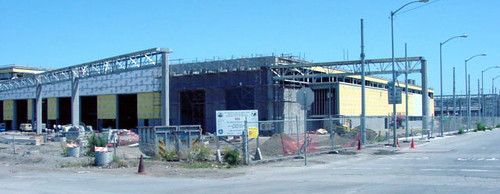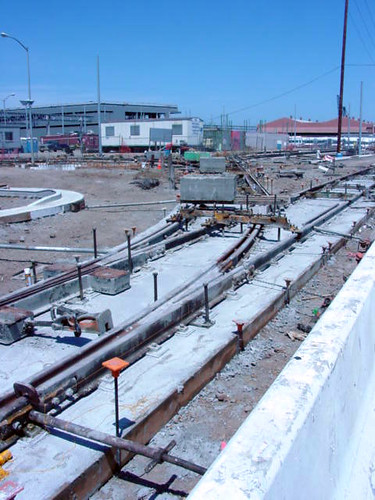Saturday, June 30, 2007
California High Speed Rail
Building a System: Portland's Legacy
21 years ago nothing was certain. However, the Portland region banded together to decide on their future. In 1986 Portland Tri-Met had 162,500 average weekday boardings, 19,600 on rail and the rest on bus. Fast forward to 2006, we see that 307,200 rides with 99,000 of those rides coming from rail. The May ridership for Portland was 110,000 average weekday boardings. What is important is that this rail push has saved gobs of cash. With a 72 cent required boost from Tri-Met versus a $1.92 for bus, you can see why the investment has paid off. 23% of Portland's operating cost is for rail yet rail makes up 32% of the ridership.
The vision of the original Lutraq plan and the network of rail lines and city centers is being quietly implemented all the time. Expected next week is an FFGA from the federal government for the I-205 Light Rail Line. Planning is underway for the Streetcar to Lake Oswego and Milwaukie Max. This plan shows that when cities put their will and collective mind into doing something it can get done. The expansion of Portland's system can be replicated but it takes time and planning. Hopefully more cities will wake up and realize the cost savings as well as quality of life improvements brought by this way of doing things.
Thursday, June 28, 2007
The Next Earthquake
A proposal to have 1:1 parking ratio in the city outside of downtown among other provisions. Just about the dumbest idea I've ever seen or heard of. Idiocy knows no bounds. Here are some other crazy provisions from a the comments...
The ordinance does NOT leave the recent C-3 (downtown) parking controls as is. In fact, it guts them. And it doesn't gut just the recent changes. It guts the fundamental controls that have existed in downtown for decades, and were the core of the City's renowned 1985 Downtown Plan, on which the Financial District we know today was built. The biggest change is not just the residential controls. The biggest, and most drastic change is the complete elimination of the limitation on commuter parking for commercial (office) buildings. The initiative would more allow (via changes to Section 151.1) more than 650% of the commuter parking currently allowed downtown! Where 100 spaces are now allowed, this initative would allow 667 spaces! This is a fact, and the math is simple:
The current controls place an absolute parking maximum equivalent to 7% of the gross floor area of an office building. 500,000 sf office = 35,000 sf parking = 100 parking spaces. Under the initative, a builder could build up to one space for every 750 square feet of office space. 500,000 sf office = 667 spaces. The words drastic and dramatic don't even begin to capture the magnitude of this change for downtown. The entire downtown has been built on a limited parking model, and only because of that reason (and only) the commute to downtown SF has the highest share of commuters taking transit outside of lower manhattan.
BART in 50 Years
Wednesday, June 27, 2007
A Visceral Response
So for places like San Francisco and New York, it isn't a question of does transit work or not, its how much more should we invest in to make it better than it already is. On the other side of the pale are these road oriented communities which are fighting hard to get transit off the ground such as Charlotte and Milwaukee. The road folks know they have a slight chance to kill transit in these places so they are throwing the kitchen sink because they are the last front in the road wars. The Anti's fight hard but in order to beat them back like we have for the last few decades we must not back down from their constant barrage of misinformation and misdirection.
An article in Newsweek suggests that politics is as I mentioned before, a visceral decision that leaves behind rational thought and that progressive minded folks shouldn't back down from a good fight. I see this as an ideological fight and when we get the chance we should sock it to the opposition Karl Rove style. Frame the issues in the most passionate way possible and set up decision makers with the facts they need to beat back the opposition. A mix of options and a vision for how all modes will work together. Cars are not the answer to everything. This is how we win.
Tuesday, June 26, 2007
Saluting Legends of a Different Track
Today we have lost another friend to the track community. J. Fred Duckett was an amazing announcer. He knew everything about the sport and always had a smile on his face. His booming voice could be heard blocks from the stadium and I can vividly remember him announcing the Texas Relays, the Kingwood Relays and specifically the State Track Meet. It's sad to know that the familiar voice that I grew up around on the track will not be there anymore. I got a chance to thank him after a race once, I told him I appreciated his knowledge and his announcing. I'd like to thank you one last time J. Fred. You will be missed. Rest In Peace.
Monday, June 25, 2007
New Muni LRV Facility
The coolest thing about going down there a few weekends ago was that I got to see how the track was going in. Since I'd never seen it before I thought it was pretty cool to see all of the industrial sized C clamps and spacers keeping the tracks an even distance apart over a heavy concrete base.






Sunday, June 24, 2007
It's Not Just People, It's Freight Too!!
Trucks keep ratcheting up the prices because of labor and fuel and wanting to impose 3 tractor trailer units per truck. Meanwhile BNSF is increasing the train length by the equivalent of almost 240 trucks! Come on America, get this crap straight!! Move it to the rails, get the intermodal really cooking, and get those centers to truly be distribution points! Rock on BNSF, Congrats on a successful 10,000 ft. train move!This is rather amazing and it shows the efficiency of rail over rubber tired alternatives. I wonder how much benefit we would get from electrifying just this one route which has 10,000 ft trains and using alternative energy. There should be a national study to look at the environmental benefits of such a move as well as a cost-benefit ratio. Has this already been done? Some cold hard numbers always help.
Friday, June 22, 2007
Making the Case for Rail Transit
Thursday, June 21, 2007
Sprawlista Argues for...Well...Sprawl
Day 1. Density is LA's Undoing... Seriously...thats what Rob says. In fact he even makes the old basketball trash talk, you can't stop me, you can only hope to contain me.
Day 2. A Greener American Dream... let us hope this is what happens. Although Rob B. Makes a fool of himself when he argues that basically we should just let inertia take us where it will.
Day 3. Mass Transit... Rob argues for PRT while Gloria Ohland argues for housing choices. I'm glad she reframed the issue on him. The transit doesn't work because it doesn't address sprawl attitude is getting tired. If there were better, cheaper technologies out there, then wouldn't we be using them now? I mean just today we pushed the gas standards up to 35 mpg by 2020. While incredibly weak, we're been letting the auto industry get away with murder by babying them. Toyota isn't going under. I want moving sidewalks and those speed tubes from Futurama, but they aren't coming as long as the auto and concrete lobbies are in Washington. And right now the most efficient way to move people on a per passenger mile basis, and most fuel efficient is rail.
Day 4. It's Coming Soon...
I would do more commentary but really i'm just annoyed that people think like this. And really, if you don't know that sprawl is bad by now, then you might never get it. Is anyone else tired of the inertia and the same old arguments about the free market. Well if the free market worked the way the libertarians wanted it to, we would have transit and we wouldn't have ridiculous sprawling suburbs. If anyone gets a chance, they should check out Jonathan Levine's book, Zoned Out. It puts all that junk to rest, at least in my mind.


